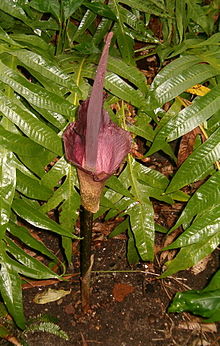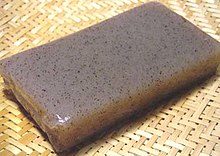Glucomannans
Glucomannans (or glucomannans ) are very similar substances made from branched carbohydrate chains . The main chain consists of D - mannose and D - glucose , with (short) side chains occurring at different distances .
Main component of the devil's tongue Amorphophallus konjac from the family of Arum , also Konjakwurzel called from which the food - thickener and the saturant konjac (konjac, Japanese = konnyaku) is produced, is a glucomannan.

structure
The main chain of the polysaccharide consists of 1,4-β- glycosidically linked D - monosaccharide units of mannose and glucose , approximately in a ratio of 2: 1. Similar to the amylose of starch, this main chain adopts a helical screw structure . Α-1,6-glycosidic monomers or short side chains of sugar residues are bound to this main chain , which make up about 8% of the molecular mass, so that a complex, branched-chain polymer is present, which, however, appears essentially like an unbranched polymer (figures refer to glucomannan from Konjac). If the "side chain" consists predominantly of individual galactose residues , it is called galactoglucomannan .
The molecular mass of glucomannan from devil's tongue is given as 200 to 2000 k Da .
Occurrence
In the cell walls of softwood , glucomannan serves as a strengthening matrix substance in addition to cellulose (it should be noted that cellulose consists exclusively of β-glycosidically bound glucose residues without side branches).
The dry rhizome of the devil's tongue contains around 40% glucomannan and is the most important source of glucomannan for human consumption.
Galactoglucomannan is the second most abundant polysaccharide in softwood (e.g. spruce ), after cellulose.
Properties and use
The ground rhizome of the devil's tongue makes the konjac flour. It is approved as a food additive in Europe under E 425 , but under certain quantity restrictions. Shirataki noodles in particular can and may contain higher levels of glucomannan. In food production, konjac is used as a thickening agent, for gelling and as a filler. Konjac has been used in Asian cuisine for around 1500 years.
Glucomannan is considered a valuable fiber and positive for intestinal health. However, consuming it can lead to flatulence , as incomplete digestion leads to metabolism by the intestinal flora , releasing carbon dioxide.
Konjac slowly swells in water to form gels that are sometimes very firm and have high tear and pressure properties. In the form of a solid gel, it is also known as konjac gum .
Konjac has the highest known water-binding capacity of all natural products , it can bind 50 times the amount of water of its own mass. That is why it is increasingly being used for satiety in diet products. Due to its highly hygroscopic properties, ingestion without enough water can lead to obstruction of the esophagus .
The European Food Safety Authority (EFSA) on 9 December 2010 in implementation of the Health Claims Regulation judged justified scientifically following health claim: "Reduction of body weight, if at least 3 g daily g in 3 portions of at least one each 1–2 glasses of water are consumed by an overweight person before a meal. "
The following health-related statements were not recognized by the EFSA due to insufficient data :
- Reduction of the glycemic load after eating ("post-prandial glycemic response")
- Maintaining normal blood sugar levels
- Maintaining normal blood triglyceride levels
- Maintaining normal bowel movements
- Reduction of possibly pathogenic microorganisms in the digestive tract
Individual evidence
- ↑ Kaname Katsuraya, Kohsaku Okuyamab, Kenichi Hatanakab, Ryuichi Oshimab, Takaya Satoc, and Kei Matsuzakic (2003): Constitution of konjac glucomannan: chemical analysis and 13C NMR spectroscopy. In: Carbohydrate Polymers 53 (2), pp. 183-189; doi: 10.1016 / S0144-8617 (03) 00039-0 .
- ↑ E. Gruber: Fundamentals of Pulp Technology (PDF; 782 kB), Fig. 8 and 9.
- ^ Entry on (1-6) -alpha-glucomannan at ChemicalBook , accessed December 30, 2011.
- ↑ Tea Hannuksela, Catherine Hervé du Penhoat: NMR structural determination of dissolved O-acetylated galactoglucomannan isolated from spruce thermomechanical pulp . In: Carbohydrate Research . tape 339 , no. 2 , 2004, p. 301-312 , doi : 10.1016 / j.carres.2003.10.025 .
- ↑ a b Konjac Glucomannan - the toughest soluble fiber
- ↑ REGULATION (EU) No COMMISSION. 1129/2011 of 11 November 2011 amending Annex II to Regulation (EC) no. 1333/2008 of the European Parliament and of the Council with regard to a list of food additives in the European Union recalled, on February 9, 2017.
- ^ DA Henry, AS Mitchell, J. Aylward, MT Fung, J. McEwen, A. Rohan: Glucomannan and risk of oesophageal obstruction . In: British Medical Journal (Clinical research ed.) . tape 292 , no. 6520 , 1986, pp. 591-592 , PMC 1339569 (free full text).
- ^ Paul B. Vanderbeek, Charles Fasano, Gerald O'Malley, Jon Hornstein: Esophageal obstruction from a hygroscopic pharmacobezoar containing glucomannan . In: Clinical Toxicology . tape 45 , no. 1 , 2007, p. 80-82 , doi : 10.1080 / 15563650601006215 .
- ↑ a b Panel on Dietetic Products, Nutrition and Allergies: Scientific Opinion on the substantiation of health claims related to konjac mannan (glucomannan) and reduction of body weight (ID 854, 1556, 3725), reduction of post-prandial glycaemic responses (ID 1559), maintenance of normal blood glucose concentrations (ID 835, 3724), maintenance of normal (fasting) blood concentrations of triglycerides (ID 3217), maintenance of normal blood cholesterol concentrations (ID 3100, 3217), maintenance of normal bowel function ( ID 834, 1557, 3901) and decreasing potentially pathogenic gastro-intestinal microorganisms (ID 1558) pursuant to Article 13 (1) of Regulation (EC) No 1924/2006 . In: EFSA Journal . tape 8 , no. 10 , 2010, p. 1798–1825 , doi : 10.2903 / j.efsa.2010.1798 .
